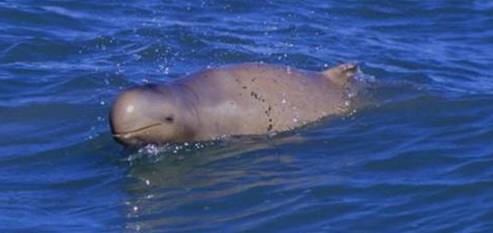
August 1, 2008
The Australian media is in a whirlwind because allegedly the “first pictures of what has been dubbed the world’s ugliest dolphin were shown on Australian television on Thursday. The snub fin dolphin with its distinctive bulbous head was first identified three years ago off Western Australia’s remote Kimberley coast.”
But, of course, photos had been published before of this dolphin.
The Queensland government published one in its official 2007 bulletin on the species, an extract of which is shown below:
Australian snubfin dolphin
Common name: Australian snubfin dolphin
Scientific name: Orcaella heinsohni
Legislative name: Orcaella brevirostris
Conservation status: The Australian snubfin dolphin is listed as ‘Rare’ under the Queensland Nature Conservation Act 1992. This dolphin was assumed to be the Irrawaddy River dolphin (Orcaella brevirostris) until 2005 when genetic tests proved that it was a separate species. It is currently only known from Australia and its status in Queensland waters is very poorly known.

Adult Australian snubfin dolphin off Townsville. Photo: Guido Parra
Description: The Australian snubfin dolphin is a relatively small cetacean (dolphin and whale family). Adults average 2 metres in length (maximum male – 2.75m, maximum female – 2.32m). It has a blunt, rounded head and no beak. There are 12-19 small, conical teeth on each side of both jaws. The blowhole is left of the midline. It has an obvious, flexible, neck, and neck creases may be present.
The flippers are large and broad, with a gently curved leading edge. The dorsal (back) fin is small and triangular with a bluntly rounded tip, and barely concave rear margin. It is situated behind the midpoint of the body. The flukes (tail fins) are notched and have a shallow concave trailing edge. The colour is generally pale to dark brown with the ventral (underside) surface lighter in colour. This species is often confused with the dugong, which lacks a dorsal fin and has a more full-bodied shape.
Habitat and distribution: It has been recorded across northern Australia (Qld, NT, WA) where it inhabits riverine, estuarine and coastal waters, but the distribution has been poorly documented.
Diet: The Australian snubfin dolphin is a generalist feeder, taking food from the bottom and the water column. Its diet consists primarily of fish, but includes cephalopods (such as squid and octopus) and crustaceans (such as prawns and crabs).
Behaviour and life history: The Australian snubfin dolphin is usually seen in groups of 5 to 6 animals, but groups of up to 15 animals have been observed. When undisturbed they typically make short dives, surfacing quietly at 30-60 sec intervals. They can submerge for up to 12 minutes when disturbed. Tail-slapping and partial jumps have been observed, but they do not leap clear of the water or bow-ride. Vocalisation (sounds/language) includes broadband clicks, pulsed sounds and whistles.
====
But now, various Australian media (see here, here, and see video here) seems to be indicating that two species may be involved. Or the reporters are confusing this 2005 discovery as a “new” one?
The media is reporting that scientists hope DNA samples taken from a group of dolphins swimming off the coast of Broome in Western Australia will establish if it represents a local sub-species or even a previously unknown species.
The researchers suspect that the group a may be a sub-species of the locally endemic snubfin dolphin, which was only identified in 2005. The snubfin has a shorter dorsal fin and more rounded snout than other dolphin species. Small populations were found off the Northern Territory and Queensland coasts.
An alternative theory is that the dolphins now being studied are an entirely distinct species.
About Loren Coleman
Loren Coleman is one of the world’s leading cryptozoologists, some say “the” leading living cryptozoologist. Certainly, he is acknowledged as the current living American researcher and writer who has most popularized cryptozoology in the late 20th and early 21st centuries.
Starting his fieldwork and investigations in 1960, after traveling and trekking extensively in pursuit of cryptozoological mysteries, Coleman began writing to share his experiences in 1969. An honorary member of Ivan T. Sanderson’s Society for the Investigation of the Unexplained in the 1970s, Coleman has been bestowed with similar honorary memberships of the North Idaho College Cryptozoology Club in 1983, and in subsequent years, that of the British Columbia Scientific Cryptozoology Club, CryptoSafari International, and other international organizations. He was also a Life Member and Benefactor of the International Society of Cryptozoology (now-defunct).
Loren Coleman’s daily blog, as a member of the Cryptomundo Team, served as an ongoing avenue of communication for the ever-growing body of cryptozoo news from 2005 through 2013. He returned as an infrequent contributor beginning Halloween week of 2015.
Coleman is the founder in 2003, and current director of the International Cryptozoology Museum in Portland, Maine.
Filed under Breaking News, Cryptotourism, CryptoZoo News, Cryptozoologists, Cryptozoology, Forensic Science, New Species, Photos, Sea Serpents, Videos